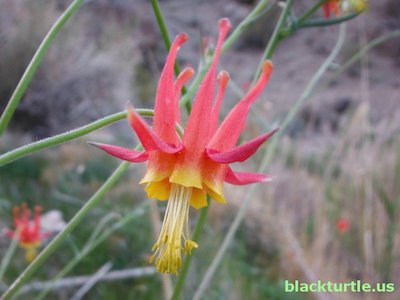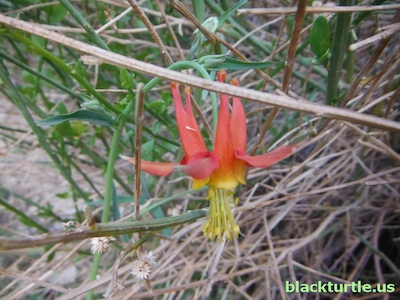|
|

|
Hedgehog Cactus
January/February
Based on personal observation,
Hedgehog Cactus is probably the fourth most common cactus growing in the
Death Valley area, with the first three most common cacti being Beavertail,
Cholla, and Cottontop. As the fourth most common
cactus in the Death Valley Area, Hedgehog Cactus is one of the cacti you
are most likely to see while in bloom and it's probably safe to say that of
the four most common cacti in the area, it easily produces the most
spectacular blooms. The brilliant magenta flowers are likely to catch your
attention should you happen to walk up a desert wash, especially around the
3000 to 4000 foot level in and around Death Valley.
(Click here for more info!)
|

|
Indigo Bush
March/April
If you happen to see purple bushes while driving through the Mojave Desert
during late March through May, there's a good chance that you are looking
at Indigo Bush. The flowers produced by this bush are intensely blue,
violet, or purple, and often it seems that the flowers outnumber the leaves,
at least for a couple weeks during the spring. A close look at an individual
flower reveals the keel, banner, and wings characteristic of pea-type
flowers, which is what should be expected since Indigo Bush is a member of
the Pea Family. Other interesting features of this plant include thorns,
pinnately divided leaves, and an interesting beaked seedpod.
(Click here for more info!)
|

|
Purple Mat
May/June
There are a lot of neat belly flowers that grow here in the desert. Some of
them are even what you might call spectacular and one of the most attractive
of the bunch is a pretty little plant known as Purple Mat which produces
purplish-pink flowers that are unexpectedly large in comparison to the plant
which produces them. Purple Mat will produce at least some
flowers even during dry years. In fact, even this year, which is the third of three consecutive
years of drought, good displays of this plant have been observed in many
areas in the Slate and Argus Ranges.
(Click here for more info!)
|


|
Desert Columbine
July/August
The Argus Range is for the most part overlooked and underestimated. Despite
the fact that the majority of the publicly accessible portion of the range has been
designated as wilderness, it is not visited by a great number of people. Not
only does the range contain several interesting abandoned mine sites,
but it also is home to a number of fascinating plants that many might not
expect to be found in such an apparently inhospitable location. Orchids,
columbine, beardtongue, evening snow, and an abundance of other attractive
and noteworthy plants grow in the Argus Range and await those willing to
hike a little ways in order to appreciate the natural beauty contained in
this wonderful wilderness area. With peaks reaching up to over 8000 feet and
lots of springs in the canyons, the range provides a variety of habitats
suitable to the needs of a diverse collection of plant species.
(Click here for more info!)
|

|
Wood Fruit Evening Primrose
September/October
The Evening Primrose Family (Onagraceae) is an interesting family,
containing an immense variety of plants which produce attractive flowers.
In fact, the Evening Primrose Family is one of those families that has been
divided into tribes due to the large number of genera it contains. In any
case, Wood Fruit Evening Primrose is a member of the Oenothera genus which
contains about 145 separate species. You are likely to find this plant
growing in the Sierra Nevada range and, more specifically, this plant has
been sighted quite a few times in the Horseshoe Meadow area.
(Click here for more info!)
|

|
Butterfly Bush
November/December
Butterfly Bush is a rather unusual-looking plant and it is somewhat
uncommon, being found almost exclusively in arid environments in areas with
a lot of limestone. Somewhat uncommon, Butterfly Bush is endemic to eastern
California and portions of Arizona, Nevada, and Utah. It can be found in
several locations in Death Valley National Park and adjacent wilderness
areas including the Funeral Range, Grapevine Mountains, Argus Range, the
vicinity of Dry Mountain, and the Panamint Range. It's pale yellow flowers
and grayish-bluish-green leaves give the plant an almost ghost-like
appearance. Although at one time classified as a member of either the
Buddlejaceae or the Loganiaceae, it is now included as a member of the
Scrophulariaceae (Figwort Family).
(Click here for more info!)
|
|
| |
|

blackturtle.us
PLANT
BLOG
BLOG INDEX
ASSOCIATED SITES:
Trona News
Rusky Ed
Any Place Education








|

















